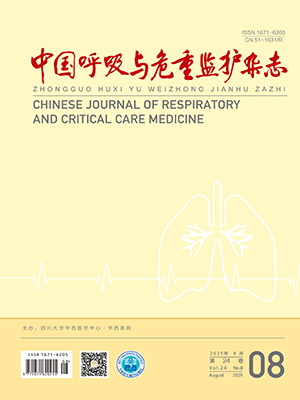| 1. |
Rose L. Strategies for weaning from mechanical ventilation: a state of the art review. Intensive Crit Care Nurs, 2015, 31(4): 189-195.
|
| 2. |
Pu L, Zhu B, Jiang L, et al. Weaning critically ill patients from mechanical ventilation: a prospective cohort study. J Crit Care, 2015, 30(4): 7-13.
|
| 3. |
王燕, 袁惠敏, 张江蓉, 等. 维生素 D 缺乏对老年重症监护患者预后的影响. 中华老年医学杂志, 2015, 34(2): 155-158.
|
| 4. |
Zhang YP, Wan YD, Sun TW, et al. Association between vitamin D deficiency and mortality in critically ill adult patients: a meta-analysis of cohort studies. Critical Care, 2014, 18(6): 684.
|
| 5. |
Vosoughi N, Kashefi P, Abbasi B, et al. The relationship between Vitamin D, clinical outcomes and mortality rate in ICU patients: a prospective observational study. J Res Med Sci, 2016, 21(5): 75-80.
|
| 6. |
中华医学会重症医学分会. 机械通气临床应用指南(2006). 中华危重病急救医学, 2007, 19(2): 65-72.
|
| 7. |
Bo Z, Li Z, Li J, et al. Effect of a quality improvement program on weaning from mechanical ventilation: a cluster randomized trial. Intensive Care Med, 2015, 41(10): 1781-1790.
|
| 8. |
Massey K, Dickerson RN, Brown RO. A review of vitamin D deficiency in the critical care population. Pharmacy, 2014, 2(1): 40-49.
|
| 9. |
Tucker A, Ybarra J, Bingham A, et al. American Society for Parenteral and Enteral Nutrition (A.S.P.E.N.) Standards of Practice for Nutrition Support Pharmacists. Nutr Clin Pract, 2015, 30(1): 139-46.
|
| 10. |
Moraes RB, Friedman G, Wawrzeniak IC, et al. Vitamin D deficiency is independently associated with mortality among critically ill patients. Clinics, 2015, 70(5): 326-332.
|
| 11. |
Chen Z, Luo Z, Zhao X, et al. Association of vitamin D status of septic patients in intensive care units with altered procalcitonin levels and mortality. J Clin Endocrinol Metab, 2015, 100(2): 516-523.
|
| 12. |
Quraishi SA, Mccarthy C, Blum L, et al. Plasma 25-hydroxy vitamin D levels at initiation of care and duration of mechanical ventilation in critically ill surgical patients. JPEN J Parenter Enteral Nutr, 2016, 97(2): 262-269.
|
| 13. |
Amrein K, Schnedl C, Holl A, et al. Effect of high-dose vitamin D3 on hospital length of stay in critically ill patients with vitamin D deficiency: the VITdAL-ICU randomized clinical trial. JAMA, 2014, 312(15): 1520-1530.
|
| 14. |
杨家来, 徐俊, 张泓. 维生素 D 对脂多糖致急性肺损伤大鼠肺组织血管紧张素转化酶 2 和维生素 D 受体表达水平的影响. 中华急诊医学杂志, 2016, 25(12): 1284-1289.
|
| 15. |
Shi Y, Liu T, Jianhua FU, et al. Vitamin D/VDR signaling attenuates lipopolysaccharide-induced acute lung injury by maintaining the integrity of the pulmonary epithelial barrier. Mol Med Rep, 2016, 13(2): 1186.
|
| 16. |
Thickett DR, Moromizato T, Litonjua AA, et al. Association between prehospital vitamin D status and incident acute respiratory failure in critically ill patients: a retrospective cohort study. BMJ Open Respir Res, 2015, 2(1): e000074.
|
| 17. |
Dancer R C, Parekh D, Lax S, et al. Vitamin D deficiency contributes directly to the acute respiratory distress syndrome (ARDS). Thorax, 2015, 70(7): 617-24.
|
| 18. |
Scheiermann J, Klinman DM. Suppressive oligonucleotides inhibit inflammation in a murine model of mechanical ventilator induced lung injury. J Thorac Dis, 2016, 8(9): 2434-2443.
|
| 19. |
杨依依, 姚尚龙, 尚游. 呼吸机相关性肺损伤发病机制研究新进展. 中华危重病急救医学, 2016, 28(9): 861-864.
|
| 20. |
Shelhamer MC, Rowan MP, Cancio LC, et al. Elevations in inflammatory cytokines are associated with poor outcomes in mechanically ventilated burn patients. J Trauma Acute Care Surg, 2015, 79(3): 431-436.
|
| 21. |
Jiang M, Song JJ, Guo XL, et al. Airway humidification reduces the inflammatory response during mechanical ventilation. Respir Care, 2015, 60(12): 1720-1728.
|
| 22. |
Larose TL, Brumpton BM, Langhammer A, et al. Serum 25-hydroxyvitamin D level, smoking and lung function in adults: the HUNT Study. Eur Respir J, 2015, 46(2): 355-363.
|
| 23. |
Kim HJ, Jang JG, Hong KS, et al. Relationship between serum vitamin D concentrations and clinical outcome of community-acquired pneumonia. Int J Tuberc Lung Dis, 2015, 19(6): 729-734.
|
| 24. |
李山峰, 吴璟奕, 邹雅茹,等. 氮末端脑钠肽前体对机械通气撤机的预测价值. 中华急诊医学杂志, 2016, 25(3): 334-337.
|
| 25. |
王慧, 马明, 陈德生, 等. 左室舒张功能不全对机械通气撤机结果的预测价值. 中华危重病急救医学, 2017, 29(5): 413-418.
|
| 26. |
秦少博, 王春, 李萍,等. 血清 25-羟维生素 D 与左心室舒张功能. 中华老年医学杂志, 2015, 34(5): 574-577.
|
| 27. |
Hansen D, Rasmussen K, Rasmussen LM, et al. The influence of vitamin D analogs on calcification modulators, N-terminal pro-B-type natriuretic peptide and inflammatory markers in hemodialysis patients: a randomized crossover study. BMC Nephrol, 2014, 15: 130.
|




